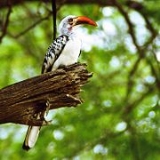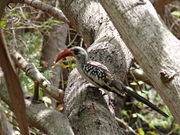
Red-billed Hornbill
Encyclopedia
Red-billed Hornbill is a relatively small species of hornbill
found in savanna and woodland of sub-Saharan Africa
. It is sometimes split
into five species, the Northern Red-billed Hornbill (T. erythrorhynchus), Western Red-billed Hornbill (T. kempi), Tanzania Red-billed Hornbill (T. ruahae), Southern Red-billed Hornbill (T. rufirostris) and Damara Red-billed Hornbill (T. damarensis), but at present most authorities considered them all to be subspecies
of a single species.


Hornbill
Hornbills are a family of bird found in tropical and subtropical Africa, Asia and Melanesia. They are characterized by a long, down-curved bill which is frequently brightly-colored and sometimes has a casque on the upper mandible. Both the common English and the scientific name of the family...
found in savanna and woodland of sub-Saharan Africa
Sub-Saharan Africa
Sub-Saharan Africa as a geographical term refers to the area of the African continent which lies south of the Sahara. A political definition of Sub-Saharan Africa, instead, covers all African countries which are fully or partially located south of the Sahara...
. It is sometimes split
Lumpers and splitters
Lumping and splitting refers to a well-known problem in any discipline which has to place individual examples into rigorously defined categories. The lumper/splitter problem occurs when there is the need to create classifications and assign examples to them, for example schools of literature,...
into five species, the Northern Red-billed Hornbill (T. erythrorhynchus), Western Red-billed Hornbill (T. kempi), Tanzania Red-billed Hornbill (T. ruahae), Southern Red-billed Hornbill (T. rufirostris) and Damara Red-billed Hornbill (T. damarensis), but at present most authorities considered them all to be subspecies
Subspecies
Subspecies in biological classification, is either a taxonomic rank subordinate to species, ora taxonomic unit in that rank . A subspecies cannot be recognized in isolation: a species will either be recognized as having no subspecies at all or two or more, never just one...
of a single species.


Description
This conspicuous bird has mainly whitish underparts and head, and grey upperparts. It has a long tail and a long and curved red bill which lacks a casque. Sexes are similar, but the female has a smaller bill. It is a large bird, at 42 cm long, but is one of the smaller hornbills. It advertises its presence with its noisy accelerating tok-tok-tok-toktoktok call.Breeding
During incubation, the female lays three to six white eggs in a tree hole, which is blocked off with a plaster of mud, droppings and fruit pulp. There is only one narrow aperture, just big enough for the male to transfer food to the mother and the chicks. When the chicks and the female are too big to fit in the nest, the mother breaks out and rebuilds the wall, then both parents feed the chicks.Feeding
This species is omnivorous, taking insects, fruit and seeds. It feeds mainly on the ground and will form flocks outside the breeding season.In popular culture
- Zazu, a character in the animated film The Lion KingThe Lion KingThe Lion King is a 1994 American animated film produced by Walt Disney Feature Animation and released by Walt Disney Pictures. It is the 32nd feature in the Walt Disney Animated Classics series...
, is a red-billed hornbill. He is also featured in the sequel, The Lion King II: Simba's PrideThe Lion King II: Simba's PrideThe Lion King II: Simba's Pride is a 1998 American direct-to-video animated film released by Walt Disney Home Video on October 27, 1998. The film is the sequel to the 1994 Disney animated film The Lion King...
and the mid-quel The Lion King 1½The Lion King 1½The Lion King 1½ is a 2004 American direct-to-video animated film released by Buena Vista Home Entertainment on February 10, 2004. The film is the third installment in the Lion King series. The DVD went to the Disney Vault in January 2005...
.
External links
- Red-billed Hornbill videos, photos & sounds on the Internet Bird Collection

